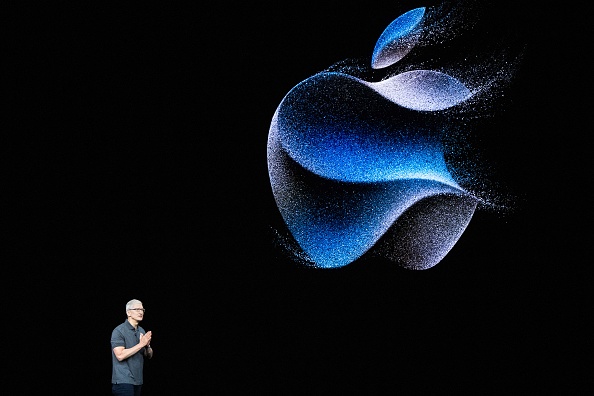Inside Apple’s Spectacular Failure to Build a Key Part for Its New iPhones
The company set out to design a silicon chip that would allow it to cut ties with Qualcomm, a longtime supplier and bitter foe
The new iPhone models unveiled last week are missing a proprietary silicon chip that Apple had spent several years and billions of dollars trying to develop in time for the rollout.
The 2018 marching orders from Apple Chief Executive Tim Cook to design and build a modem chip—a part that connects iPhones to wireless carriers—led to the hiring of thousands of engineers. The goal was to sever Apple’s grudging dependence on Qualcomm, a longtime chip supplier that dominates the modem market.
The obstacles to finishing the chip were largely of Apple’s own making, according to former company engineers and executives familiar with the project.
Apple had planned to have its modem chip ready to use in the new iPhone models. But tests late last year found the chip was too slow and prone to overheating. Its circuit board was so big it would take up half an iPhone, making it unusable.
Investors had counted on Apple saving money with an in-house chip to help compensate for weak demand in the larger smartphone market. Apple—which hasn’t publicly acknowledged its modem project, much less its shortcomings—is estimated to have paid more than $7.2 billion to Qualcomm last year for the chips.
Engineering teams working on Apple’s modem chip have been slowed by technical challenges, poor communication and managers split over the wisdom of trying to design the chips rather than buy them, these people said. Teams were siloed in separate groups across the U.S. and abroad without a global leader. Some managers discouraged the airing of bad news from engineers about delays or setbacks, leading to unrealistic goals and blown deadlines.
“Just because Apple builds the best silicon on the planet, it’s ridiculous to think that they could also build a modem,” said former Apple wireless director Jaydeep Ranade, who left the company in 2018, the year the project began.
There were two reasons for the push, said former Apple executives and engineers familiar with the matter: Apple believed it could replicate the success of the microprocessor chips it designed for iPhones. Adoption of those chips fattened profit margins and improved performance for billions of devices. Second, Apple wanted to sever ties with Qualcomm, which it had accused in a 2017 lawsuit of overcharging for its patent royalties.
The companies settled the suit in 2019, and Apple, facing the expiration of its previous Qualcomm agreement, announced a deal last week to continue buying the company’s modem chips through 2026. Apple isn’t expected to produce a comparable chip until late 2025, people familiar with the matter said. There could be further delays, these people said, but the company believes it will eventually succeed.
Apple found that designing a microprocessor, essentially a tiny computer to run software, was easy by comparison. Modem chips, which transmit and receive wireless data, must comply with strict connectivity standards to serve wireless carriers around the world.
“These delays indicate Apple didn’t anticipate the complexity of the effort,” said Serge Willenegger, a former longtime Qualcomm executive who left the company in 2018 and doesn’t know the current state of the Apple chip. “Cellular is a monster.”
Apple’s push to build more of the various semiconductors used in its products stretches back more than a decade. In 2010, the company began using its own processing chips in iPhones and iPads. The chips helped Apple outperform many of its Android rivals, which relied on chips from Qualcomm, Taiwan-based MediaTek and other makers.
The company in 2020 began replacing processor chips from Intel, used for years in Mac computers, with a proprietary chip that allowed its laptops to run faster and generate less heat, improvements that helped boost flagging Mac sales. The Apple chip also saved the company an estimated $75 to $150 on every computer.
Credit for the success of Apple processor chips brought praise and increased authority to Johny Srouji, the company’s chip leader. “After shipping the first iPhone, we decided that the best way to deliver the best experience to our customers is to own and develop and design our silicon in-house,” Srouji said this year at Technion-Israel Institute of Technology, his alma mater.
Split screen
Apple code-named its modem chip project Sinope, after the nymph in Greek mythology who outsmarted Zeus. It began taking shape in 2018, following the directive of Cook, Srouji, and others for Apple to build its own wireless components, said Chris Deaver, a former Apple human-resources executive and co-founder of BraveCore consultants.
By then, Apple’s relationship with Qualcomm had turned ugly. The companies bickered and swapped accusations of lying, theft and monopolistic practices.
Rubén Caballero, Apple’s longtime head of wireless, supported the Intel chip partnership at the time, while Srouji, senior vice president of hardware technologies, backed the pursuit of a company-built chip, said people involved in the project. Caballero left Apple in 2019.
Many members of Caballero’s team who were versed in wireless chip design were placed under Srouji. Other employees engaged in complementary wireless work, such as antenna design, were split off into the hardware engineering group. One of the top project managers on Srouji’s team had no background in wireless technology, said people who worked on the project.
Apple, which had been poaching engineering talent from Qualcomm for years, stepped up those efforts in March 2019. The company announced a new engineering hub in San Diego, Qualcomm’s hometown, and planned to add around 1,200 local jobs. That summer, Apple announced the acquisition of Intel’s wireless team and a portfolio of wireless patents.
Srouji flew to Munich to greet Apple’s newly acquired Intel wireless employees in December 2019. He told a gathering that the modem-chip project would be a game changer for Apple, the next step in the company’s evolution, said people who watched the meeting. He said the chip would distinguish Apple devices, as Apple’s processors had done.
As Apple filled the project’s ranks with Intel engineers and others hired from Qualcomm, company executives set a goal to have the modem chip ready for fall 2023. It soon became apparent to many of the wireless experts on the project that meeting the goal was impossible.
Apple found that employing the brute force of thousands of engineers, a strategy successful for designing the computer brain of its smartphones and laptops, wasn’t enough to quickly produce a superior modem chip.
Tall order
Modem chips are trickier to make than processing chips because they must work seamlessly with 5G wireless networks, as well as the 2G, 3G and 4G networks used in countries around the world, each with its own technological quirks. Apple microprocessors run software programs designed solely for its iPhones and laptops.
Apple executives who didn’t have experience with wireless chips set tight timelines that weren’t realistic, former project engineers said. Teams had to build prototype versions of the chips and certify they would work with the many wireless carriers worldwide, a time-consuming job.
Executives better understood the challenge after Apple tested its prototypes late last year. The results weren’t good, according to people familiar with the tests. The chips were essentially three years behind Qualcomm’s best modem chip. Using them threatened to make iPhone wireless speeds slower than its competitors.
The company scratched plans to use the chips in Apple’s 2023 models, and the planned rollout was moved to 2024. Eventually, Apple executives realized the company wouldn’t meet that goal either. Apple instead opened negotiations with Qualcomm to continue supplying the modem chips. Apple’s licensing deal with Qualcomm expires in April 2025, though it can be extended for another two years.
Apple has the cash and the desire to keep pursuing its modem chip, according to people involved with the project.
“Apple isn’t going to give up,” said Edward Snyder, a managing director of Charter Equity Research and a wireless industry expert. “They hate Qualcomm’s living guts.”
 Copyright 2020, Dow Jones & Company, Inc. All Rights Reserved Worldwide. LEARN MORE
Copyright 2020, Dow Jones & Company, Inc. All Rights Reserved Worldwide. LEARN MORE
Australia’s housing market defies forecasts as prices surge past pandemic-era benchmarks.
Records keep falling in 2025 as harbourfront, beachfront and blue-chip estates crowd the top of the market.
JPMorgan Chase has a ‘strong bias’ against adding staff, while Walmart is keeping its head count flat. Major employers are in a new, ultra lean era.
It’s the corporate gamble of the moment: Can you run a company, increasing sales and juicing profits, without adding people?
American employers are increasingly making the calculation that they can keep the size of their teams flat—or shrink through layoffs—without harming their businesses.
Part of that thinking is the belief that artificial intelligence will be used to pick up some of the slack and automate more processes. Companies are also hesitant to make any moves in an economy many still describe as uncertain.
JPMorgan Chase’s chief financial officer told investors recently that the bank now has a “very strong bias against having the reflective response” to hire more people for any given need. Aerospace and defense company RTX boasted last week that its sales rose even without adding employees.
Goldman Sachs , meanwhile, sent a memo to staffers this month saying the firm “will constrain head count growth through the end of the year” and reduce roles that could be more efficient with AI. Walmart , the nation’s largest private employer, also said it plans to keep its head count roughly flat over the next three years, even as its sales grow.
“If people are getting more productive, you don’t need to hire more people,” Brian Chesky , Airbnb’s chief executive, said in an interview. “I see a lot of companies pre-emptively holding the line, forecasting and hoping that they can have smaller workforces.”
Airbnb employs around 7,000 people, and Chesky says he doesn’t expect that number to grow much over the next year. With the help of AI, he said he hopes that “the team we already have can get considerably more work done.”
Many companies seem intent on embracing a new, ultralean model of staffing, one where more roles are kept unfilled and hiring is treated as a last resort. At Intuit , every time a job comes open, managers are pushed to justify why they need to backfill it, said Sandeep Aujla , the company’s chief financial officer. The new rigor around hiring helps combat corporate bloat.
“That typical behavior that settles in—and we’re all guilty of it—is, historically, if someone leaves, if Jane Doe leaves, I’ve got to backfill Jane,” Aujla said in an interview. Now, when someone quits, the company asks: “Is there an opportunity for us to rethink how we staff?”
Intuit has chosen not to replace certain roles in its finance, legal and customer-support functions, he said. In its last fiscal year, the company’s revenue rose 16% even as its head count stayed flat, and it is planning only modest hiring in the current year.
The desire to avoid hiring or filling jobs reflects a growing push among executives to see a return on their AI spending. On earnings calls, mentions of ROI and AI investments are increasing, according to an analysis by AlphaSense, reflecting heightened interest from analysts and investors that companies make good on the millions they are pouring into AI.
Many executives hope that software coding assistants and armies of digital agents will keep improving—even if the current results still at times leave something to be desired.
The widespread caution in hiring now is frustrating job seekers and leading many employees within organizations to feel stuck in place, unable to ascend or take on new roles, workers and bosses say.
Inside many large companies, HR chiefs also say it is becoming increasingly difficult to predict just how many employees will be needed as technology takes on more of the work.
Some employers seem to think that fewer employees will actually improve operations.
Meta Platforms this past week said it is cutting 600 jobs in its AI division, a move some leaders hailed as a way to cut down on bureaucracy.
“By reducing the size of our team, fewer conversations will be required to make a decision, and each person will be more load-bearing and have more scope and impact,” Alexandr Wang , Meta’s chief AI officer, wrote in a memo to staff seen by The Wall Street Journal.
Though layoffs haven’t been widespread through the economy, some companies are making cuts. Target on Thursday said it would cut about 1,000 corporate employees, and close another 800 open positions, totaling around 8% of its corporate workforce. Michael Fiddelke , Target’s incoming CEO, said in a memo sent to staff that too “many layers and overlapping work have slowed decisions, making it harder to bring ideas to life.”
A range of other employers, from the electric-truck maker Rivian to cable and broadband provider Charter Communications , have announced their own staff cuts in recent weeks, too.
Operating with fewer people can still pose risks for companies by straining existing staffers or hurting efforts to develop future leaders, executives and economists say. “It’s a bit of a double-edged sword,” said Matthew Martin , senior U.S. economist at Oxford Economics. “You want to keep your head count costs down now—but you also have to have an eye on the future.”
A cluster of century-old warehouses beneath the Harbour Bridge has been transformed into a modern workplace hub, now home to more than 100 businesses.
By improving sluggish performance or replacing a broken screen, you can make your old iPhone feel new agai

























